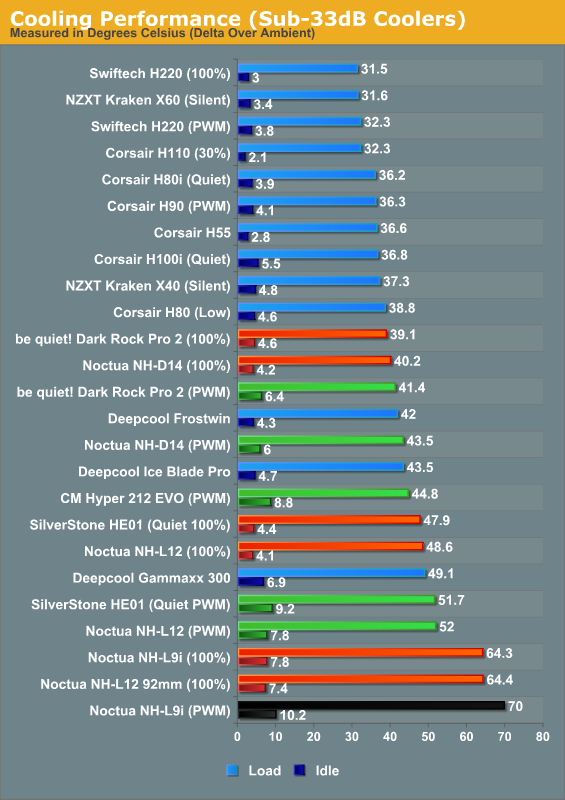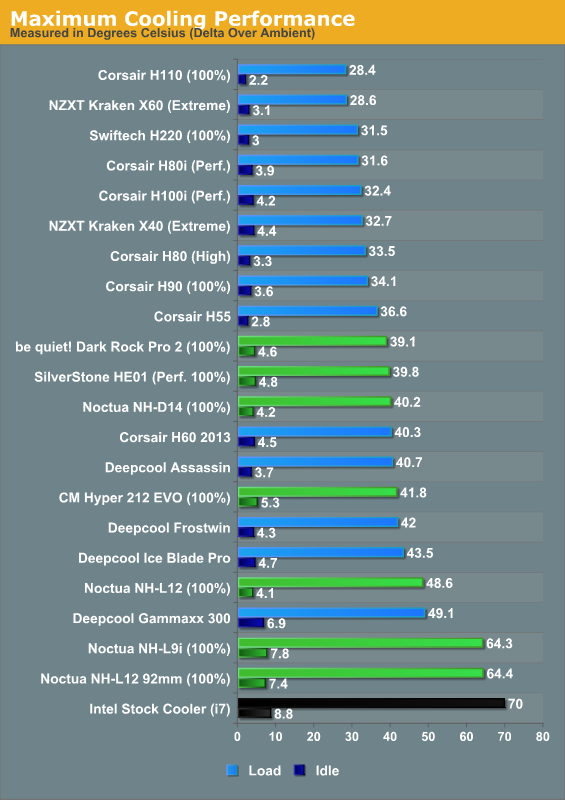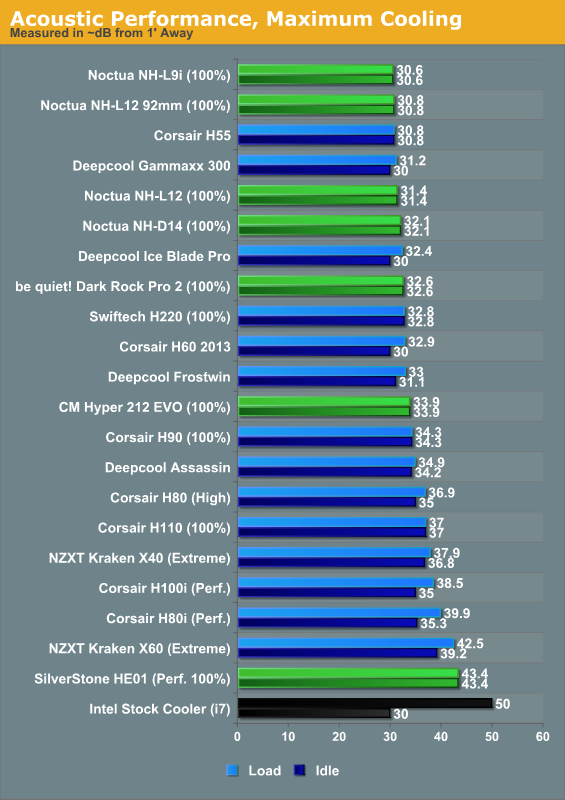CPU Air Cooler Roundup: Six Coolers from Noctua, SilverStone, be quiet!, and Cooler Master
by Dustin Sklavos on March 14, 2013 2:40 AM EST- Posted in
- Cases/Cooling/PSUs
- Cooler Master
- SilverStone
- cooling
- Noctua
- be
Silent Cooling Performance and Absolute Performance
Testing cases is in some ways much simpler than testing coolers, and a large part of that is because outside of an integrated fan controller, there's really not as much variability in the case's stock performance. Coolers, on the other hand, immediately benefit from the motherboard's fan control, and that has to be taken into account. They also have a more direct effect on the CPU's overall thermal performance. That means we need to break down the results into more useful metrics.
The first one is for silent performance. As a noise cap, I've chosen 33dB. Any coolers or settings that resulted in idle or load noise above 33dB have been pruned from the chart.

While every cooler I've tested today makes an appearance on this chart, the closed loop liquid coolers unfortunately have a clear advantage here. These are all quality units using excellent fans, though, and I'm keen to point out that you have to go to a 240mm or 280mm radiator before the closed loop units take a decisive lead. Generally speaking, you can get close to a 120mm or 140mm closed loop's cooling potential in an air cooler with comparable noise levels.
I'm keen to point out that Cooler Master's inexpensive Hyper 212 EVO actually does put in a pretty good showing here. Users on a budget would do well to note that it actually beats SilverStone's much larger Heligon HE01 when the Heligon's fan isn't cranked up.
With silent cooling broken down, let's take a look at the absolute maximum performance that can be gleaned from the coolers we've tested so far.

As it turns out, the closed loop coolers have a bit more headroom left in them compared to the majority of the air coolers tested. Our top performing trio is pretty much neck and neck for thermal performance, and even the Cooler Master Hyper 212 EVO is able to get awfully close to them. If you want high end air performance, you can definitely have it at a good price.

Of our big winners, though, Noctua and be quiet!'s solutions prove to be the quietest. SilverStone's Heligon may be able to produce comparable thermals, but that 38mm thick fan has to do an awful lot of grunt work to get there.










63 Comments
View All Comments
stennan - Thursday, March 14, 2013 - link
Hey Dustin, great review!Some friendly feedback: could you show some more pictures of the coolers tested earlier in review/roundup? It wasn't until the last page that the coolers were shown, also pictures of the cooler on the motherboard or in the case would be nice.
Keep up the work!
cbrownx88 - Thursday, March 14, 2013 - link
I'd buy a Noctua cooler in a heartbeat if they didtn have those god awful colored fans.cmdrdredd - Thursday, March 14, 2013 - link
You can use any 140mm fans you wantmapesdhs - Friday, March 15, 2013 - link
Thoroughly agree! I bought a Noctua NF-A15 140mm to replace the stock rear fan in a
Coolermaster HAF 932 case. The Noctua fan performs fantastically well, but the colour
scheme is horrible. Having said that, Noctua's packaging and presentation is very good.
Opening the fan pack feels like a special event, it all has a certain luxury sheen which at
least makes one feel the high price is going to be worth it.
Ian.
K1wi - Thursday, March 14, 2013 - link
I'd love the NH-L12 for a compact build as I'm a huge Noctua fan (best post-purchase support I've ever encountered), but it looks like it blocks the top PCI-e slot, so its a no-go for me. Its a pity because it looks like it only barely does... I wonder why they didn't choose to offset it to stay out of the PCI-e area and rather more over the top of the board where most ITX boards place their chipset stuff etc.That only leaves the NH-L9i, which is more about reducing noise than improving thermals :(
seven2nine - Thursday, March 14, 2013 - link
underEase of installation
first paragraph "surrounding all the coolers here but but...."
Lord 666 - Thursday, March 14, 2013 - link
After happily winning a z77 Sabertooth on Anandtech, was bummed my existing Zalman would not fit over the armor.Without a doubt, will the NH-D14 fit?
garadante - Thursday, March 14, 2013 - link
Honestly, these closed loop liquid cooler results aren't necessarily valid, as fifteen minutes of load testing probably isn't enough to thermally saturate the coolant. As soon as the coolant is thermally saturated, shouldn't the performance be based purely on the heat transfer of the radiators between the cooling medium, intake air, and the heat transfer medium, the coolant? At this point, I imagine a high end air cooler would perform more consistently in the long run.Liquid cooling really shines with actual cooling loops, built yourself, with high end components, large radiator surface area, and more coolant to thermally saturate than is present in these closed loop coolers. There's only so much heat a 120mm closed loop cooler can dissipate, once the coolant reaches it's thermal saturation point.
These closed loop coolers are better for bursts of activity, but I have my doubts with them in extended torture testing. Anyway, I'd rather use a 480mm radiatior, or even a 480 paired with a 240/360, so I can run the fans at nothing/almost nothing overnight, with the heat capacity of the coolant taking care of the cooling, the only sound coming from the pump.
ShieTar - Friday, March 15, 2013 - link
Potentially good point, but lets throw some numbers in to test it:Heat Capacity of water is about 4 J/g/K, so if the closed-loop system come with 1/4l of water (I doubt it is more than that), they can take 1 kJ/K. The overclocked 2700K can possibly touch 100W when overclocked and stressed, so it puts out enough power to heat up the water by 1K every 10 seconds, or 90K over 15 minutes if you ignore the cooling effect of its radiator.
With this amount of power I would guess that this small, closed-loop systems are already relatively saturated and stable. Of course if you have a big system with 4 liters of water and a few Kg of radiator metal, you are looking at a much higher heat capacity of more than 20kJ/K, and if you just use normal loads (~50W) instead of a torture test, you could indeed cool for an hour or two on heat capacity alone. If you add an overclocked 680 or 7970 to the loop though, even this big system should hit saturation within much less than one hour.
mapesdhs - Friday, March 15, 2013 - link
I talked to a German company which specialises in water cooling. They told me that to achieve
cooling performance "significantly better" than a high-end air cooler would require one to spend
at least 200 UKP ($300+). Otherwise, unless there are other considerations, a water cooler is
not going to beat a good air cooler.
This is why I keep bagging used TRUEs, etc. off eBay when I can, typically get them with
fans included for around 10 to 17 UKP. Also just bought a Venomous-X for only 25 UKP total.
Ian.